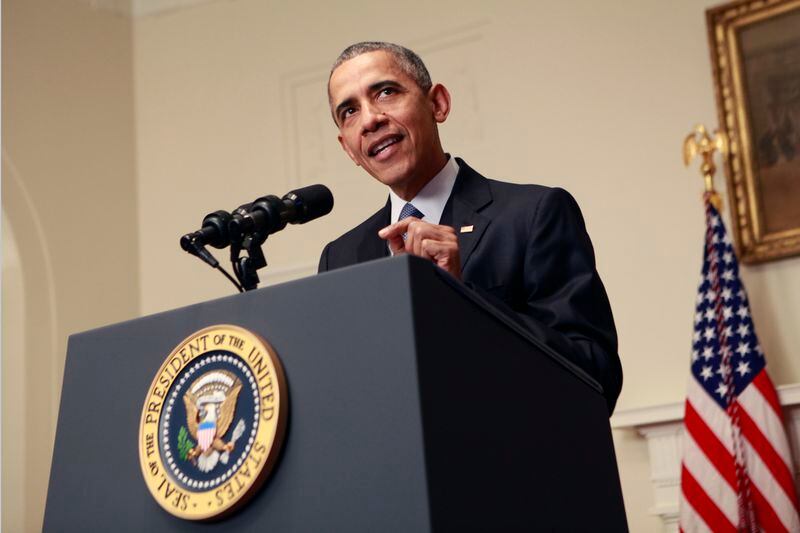President Donald Trump last year withdrew the United States from the Paris climate agreement.
» RELATED: We have 12 years left to act on climate change, UN warns
In a live stream at The White House, Trump said, “In order to fulfill my solemn duty to protect America and its citizens, the U.S. will withdraw form the Paris climate accord.”
Trump announced the country will immediately cease implementation of the non-binding accord, including ending implementation of the country’s Nationally Determined Contributions and pledge to the Green Climate Fund.
» RELATED: How climate change could cause 26,000 more US suicides by 2050
But, he said, the administration will start to negotiate re-entry into the accord under terms that are fair to both the U.S. and its taxpayers or negotiate a new deal that benefits the nation.
Three years after the 2015 accord, which includes nearly 200 countries, the the United Nations' Intergovernmental Panel on Climate Change issued a grim report warning if governments don't act on climate change soon, more devastation is to be expected.
Here are 9 things you should know about the Paris climate agreement:
Credit: Dennis Brack-Pool
Credit: Dennis Brack-Pool
What is it?
The Paris climate agreement, also referred to as the Paris climate accord, Paris climate deal or Paris agreement is a pact sponsored by the United Nations to bring the world’s countries together in the fight against climate change.
What is the overall mission?
Countries that sign on to be a part of the pact agreed to limit the century’s global average temperature increase to no more than 2 degrees Celsius (3.6 degrees Fahrenheit) above the levels from the years 1850-1900 (the pre-industrial era).
The agreement also states a more rigid goal of limiting temperature increases to only 1.5 degrees Celsius (2.7 degrees Fahrenheit) above pre-industrial era levels.
» RELATED: Hurricane season is officially here: How much damage will 2018 bring?
What is each country responsible for?
Participating nations made a historic pact on Dec. 12, 2015, in Paris, France, to adopt green energy sources, cut down on greenhouse gas emissions and limit the rise of global temperatures (as mentioned in the overall mission).
Under the agreement, every country has an individual plan (or “Nationally Determined Contributions”) to tackle its greenhouse gas emissions.
» RELATED: Is chocolate really going extinct because of climate change?
For example, under the Obama administration, the country vowed to cut its emissions by 26 to 28 percent below 2005 levels by the year 2025.
The U.S. also pledged $3 billion to the Green Climate Fund, which helps developing countries adapt and mitigate practices to fight climate change.
The overall agreement asks developed countries to provide $100 billion to the fund.
» RELATED: Climate change will internally displace 143 million people by 2050, scientists warn
When did the agreement enter into force?
The agreement went into effect on Nov. 4, 2016, 30 days after at least 55 countries representing at least 55 percent of the world’s global emissions ratified it on Oct. 5, 2016.
Is it legally binding?
According to the U.N.’s website on climate change, the agreement has a “hybrid of legally binding and non-binding provisions.”
But there’s no clear cut consequence or penalty for countries that fall short of their pledged goals.
» RELATED: Worst global warming predictions likely the most accurate, study finds
How many nations are part of the accord?
Of the 196 negotiating countries that signed the agreement, 181 parties have ratified it as of today.
According to the Independent, the Russian government said it fully supports the agreement, but added its goals would be less effective without the participation of major countries.
How does withdrawal from the agreement work?
According to the New York Times, governments can either request a formal withdrawal, which takes four years, or they could withdraw from the United Nations Framework Convention on Climate Change altogether.
Withdrawing from the underlying convention would signal a country’s departure from any United Nations-sponsored climate discussions.
How does U.S. withdrawal affect the country and global efforts against climate change?
According to the New York Times, the U.S. withdrawal may "seriously weaken global efforts to avoid drastic climate change."
Instead of cutting emissions to 26 to 28 percent below 2005 levels by 2025 (the nation’s original pledge under the Obama administration), an analysis by Rhodium Group estimated that emissions would fall just 15 to 19 percent below 2005 levels.
"Pulling out of Paris is the biggest thing Trump could do to unravel (former President Barack) Obama's climate legacy," Axios' Jonathan Swan wrote in 2017, before the official withdrawal. "It sends a combative signal to the rest of the world that America doesn't prioritize climate change and threatens to unravel the ambition of the entire deal."
The effects of U.S. withdrawal on global efforts heavily depend on how other countries react, but the nation could still face some diplomatic consequences for leaving, including possible carbon tariffs imposed on the U.S., the New York Times reported.
Would the U.S. be the only UN country not supporting the deal?
Initially, two other UN-member countries weren’t supportive of the Paris Climate agreement, either: Nicaragua and Syria.
But both signed on in late 2017.
According to the Financial Times, Nicaragua is responsible for only 0.03 percent of global greenhouse gas emissions.
Syria, which is in the middle of a civil war, was responsible for 0.19 percent of global emissions in 2011, when the war began.
In 2014, according to the Environmental Protection Agency, the United States was responsible for approximately 15 percent of the world's greenhouse gas emissions.
And according to the New York Times, while China surpassed the U.S. a decade ago as the current number one carbon polluter, the U.S. is the biggest carbon polluter in history.
Read the full text PDF of the Paris climate agreement.
This story has been updated.



/cloudfront-us-east-1.images.arcpublishing.com/ajc/P7DYBH6TO7FEKG4SUXQQKADRXE.jpg)



